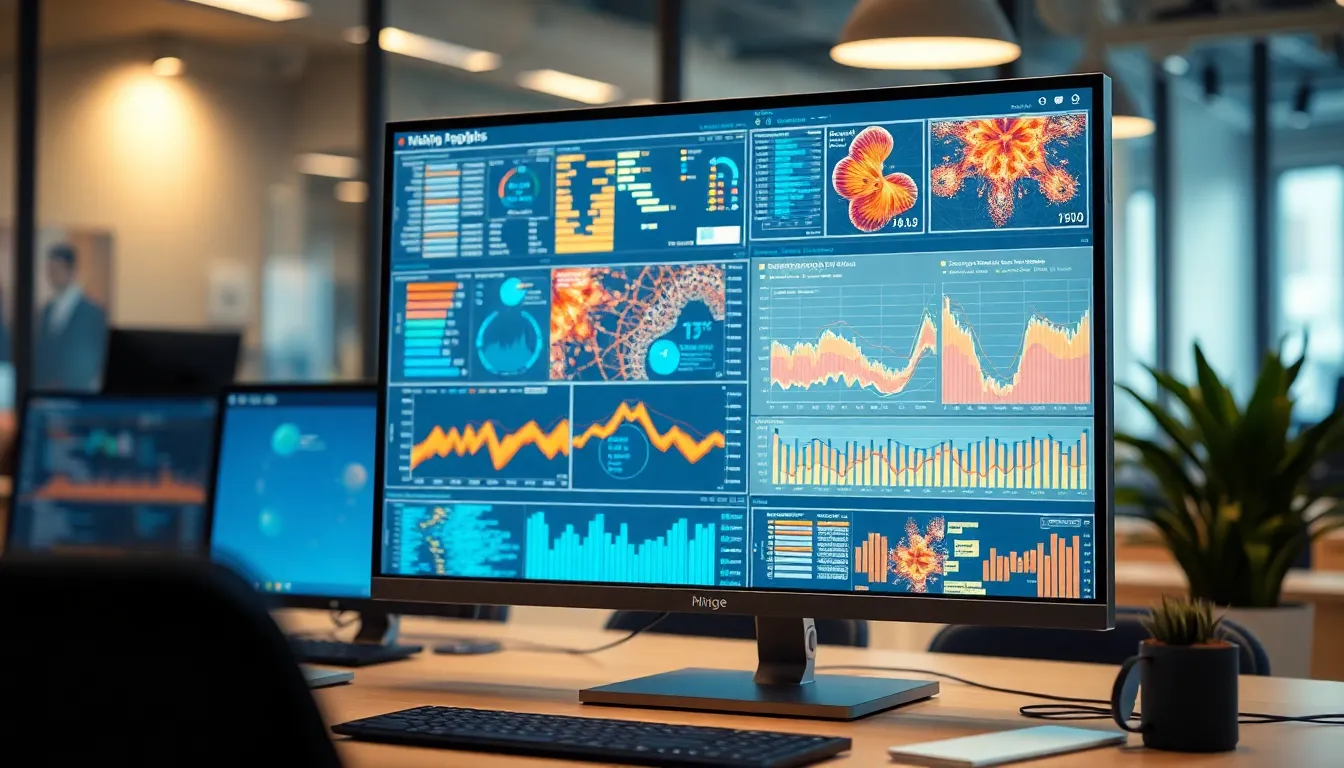In a world where selfies reign supreme and every meal is a potential Instagram star, visual artificial intelligence is stepping into the spotlight. Imagine a tech-savvy assistant that not only recognizes your cat but can also distinguish between a cat and a particularly fluffy potato. This isn’t just a quirky novelty; it’s reshaping industries from healthcare to retail, making everything smarter and more efficient.
Table of Contents
ToggleUnderstanding Visual Artificial Intelligence
Visual artificial intelligence encompasses technology that interprets and analyzes visual data. This capability extends beyond simple object recognition, offering profound insights across various sectors.
Definition and Overview
Visual artificial intelligence refers to systems that enable machines to understand, interpret, and respond to visual information. It integrates computer vision algorithms, machine learning models, and neural networks to perform tasks such as image classification, facial recognition, and object detection. By processing visual input, these systems enhance user experience and decision-making. Examples include AI applications in autonomous vehicles, which rely on real-time visual analysis to navigate environments safely.
Importance in Today’s Technology Landscape
Visual artificial intelligence plays a crucial role in modern technology. It enhances user interactions through smart devices, improving functionalities like augmented reality and facial recognition. Industries such as retail benefit from visual AI via personalized shopping experiences and inventory management. Healthcare utilizes this technology for medical imaging analysis, leading to faster and more accurate diagnoses. Visual AI drives advancements in automation, augmenting traditional processes and fostering innovation across various fields.
Key Components of Visual Artificial Intelligence

Visual Artificial Intelligence comprises several essential components, with machine learning and computer vision being foundational elements that drive its functionality.
Machine Learning
Machine learning algorithms enable systems to learn from visual data. They analyze patterns, which allows for improved accuracy in tasks such as image classification and facial recognition. A robust dataset enhances the training process, making predictions more reliable. Algorithms like convolutional neural networks (CNNs) excel in processing large volumes of visual input. Continuous updates of these models contribute to better performance over time, as they adapt to new data variations. Integration of machine learning in visual AI allows industries to automate processes, ultimately increasing efficiency.
Computer Vision
Computer vision technology interprets visual information from the world. It processes images and videos, extracting meaningful information that machines can understand. This component aids in tasks such as object detection, tracking, and scene reconstruction. Advanced techniques, including image segmentation and feature extraction, improve insights drawn from visual data. Applications in augmented reality highlight the power of computer vision, offering immersive user experiences. Retailers utilize this technology for inventory tracking and customer engagement, demonstrating its practical benefits across sectors.
Applications of Visual Artificial Intelligence
Visual artificial intelligence plays a pivotal role in transforming various sectors, enhancing operations and creating innovative solutions. Key applications include healthcare, the automotive industry, and retail and e-commerce.
Healthcare
Healthcare providers increasingly depend on visual AI for medical imaging analysis. Systems analyze radiology images and identify conditions, facilitating timely interventions. Deep learning algorithms enhance the accuracy of image classification, resulting in improved diagnostic precision. For instance, automated systems can detect tumors earlier than human radiologists, potentially saving lives. Visual AI also aids in monitoring patient health through advanced imaging techniques, allowing for better treatment outcomes.
Automotive Industry
In the automotive industry, visual AI significantly contributes to the development of autonomous vehicles. These systems process data from multiple cameras and sensors, enabling accurate object detection and recognition. Companies leverage this technology to enhance safety features like lane-keeping assistance and automatic braking. Visual AI supports real-time decision-making, improving navigation and traffic management. Advanced driver-assistance systems incorporate this technology, making roads safer for drivers and pedestrians alike.
Retail and E-commerce
Retail and e-commerce sectors harness visual AI to deliver personalized shopping experiences. Systems analyze customer behavior and preferences through visual data, tailoring product recommendations accordingly. Enhanced image recognition capabilities enable efficient inventory management and quick product searches. Retailers benefit from augmented reality applications that allow customers to visualize products in their environments. This approach enhances customer engagement and improves sales conversion rates through targeted marketing strategies.
Challenges in Visual Artificial Intelligence
Visual artificial intelligence faces several challenges that can hinder its effectiveness. These challenges encompass ethical concerns and technical limitations.
Ethical Concerns
Ethical concerns arise when developing and deploying visual AI systems. Privacy issues become a significant factor as facial recognition and surveillance technologies collect vast amounts of personal data. Users often worry about unauthorized use of their images. Bias in AI algorithms presents another critical issue, as datasets may not represent diverse populations, leading to inaccurate results. Accountability becomes challenging when visual AI systems produce erroneous outcomes; determining responsibility for mistakes requires clear guidelines. To foster trust, transparency in how these systems operate is essential, encouraging ethical applications in various sectors.
Technical Limitations
Technical limitations also impede the advancement of visual artificial intelligence. Access to high-quality labeled datasets proves challenging, as many applications require extensive training data for accuracy. Computational power affects processing speed; powerful hardware is necessary to handle large volumes of visual information effectively. Generalization can be problematic; systems might struggle to interpret images outside their training contexts. Variability in lighting and occlusion complicates object detection tasks, resulting in decreased reliability under diverse conditions. Researchers continue to address these limitations, seeking solutions to enhance the robustness of visual AI technologies.
Future Trends in Visual Artificial Intelligence
Visual artificial intelligence continues to evolve rapidly, pushing boundaries and expanding its applications across industries. Key advancements in technology and potential societal impacts shape this progression.
Advancements in Technology
Deep learning algorithms enhance visual AI by improving image classification accuracy. Convolutional neural networks process visual data more efficiently, adapting to larger datasets. Researchers are developing real-time object detection systems, which boost safety in autonomous vehicles. Integration of augmented reality applications transforms user experiences, facilitating interactive engagements. Furthermore, increased computational power in hardware supports complex model training and faster processing times. Advances in edge computing enable on-device processing, enhancing privacy and responsiveness.
Potential Impact on Society
Visual AI significantly alters how individuals interact with technology daily. In healthcare, advanced diagnostic tools enable quicker disease detection and treatment, improving patient outcomes. Retail sectors benefit from personalized shopping experiences that adapt to consumer preferences, promoting customer satisfaction. Surveillance systems, while raising privacy concerns, enhance security in public spaces and businesses. Education sectors leverage visual AI in learning platforms, fostering personalized educational experiences. With ongoing advancements, societal applications continue to emerge, driving innovation and reshaping everyday life.
Visual artificial intelligence is reshaping how industries operate and interact with technology. Its ability to analyze and interpret visual data is not just a technological advancement; it’s a catalyst for innovation across various sectors. As visual AI continues to evolve, its applications will likely expand, offering new solutions to age-old challenges.
While the benefits are significant, addressing ethical concerns and technical limitations remains crucial for its responsible development. The future of visual AI holds immense potential, promising to enhance efficiency and user experiences in ways previously unimaginable. Embracing these advancements will be vital for staying competitive in an increasingly digital landscape.




